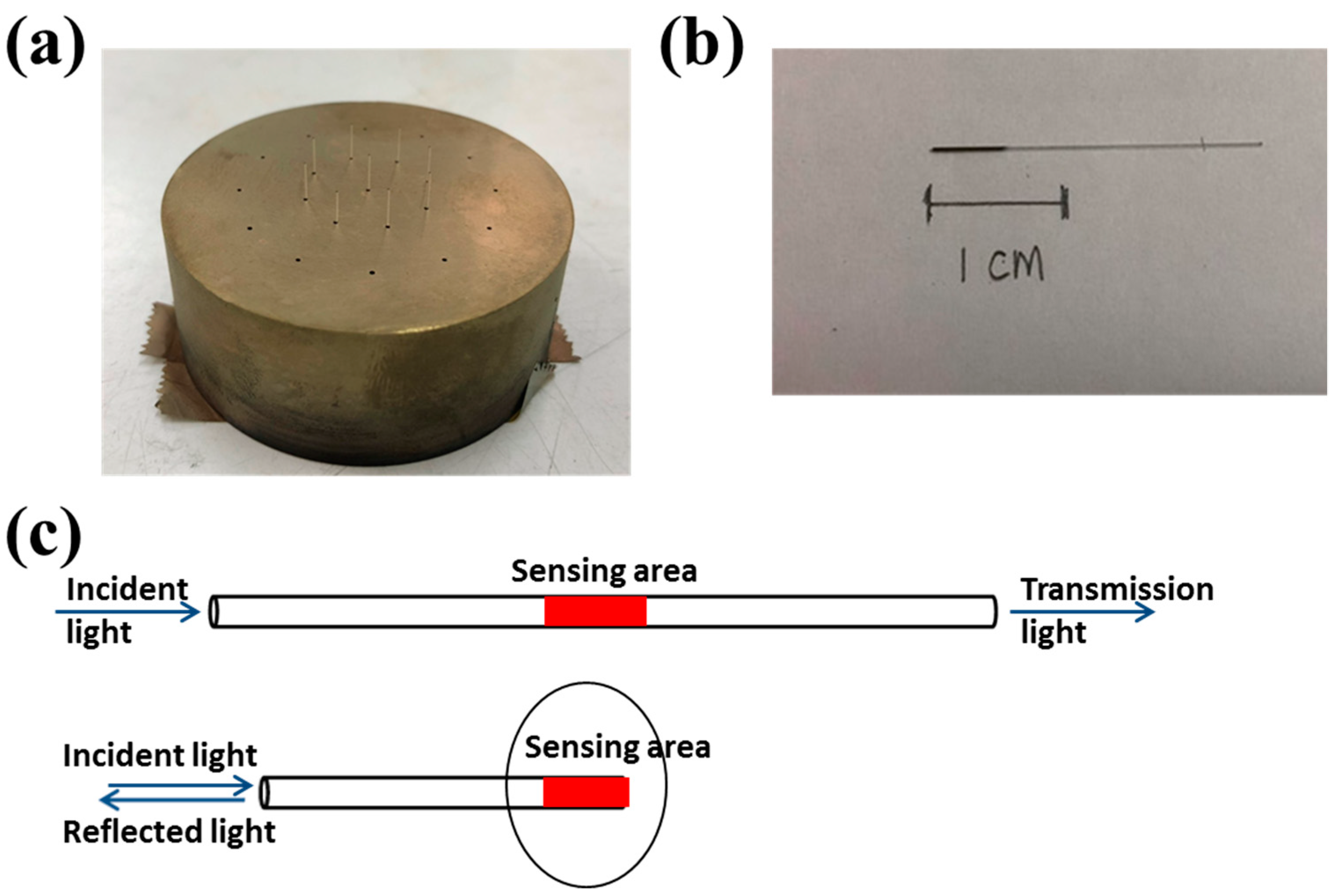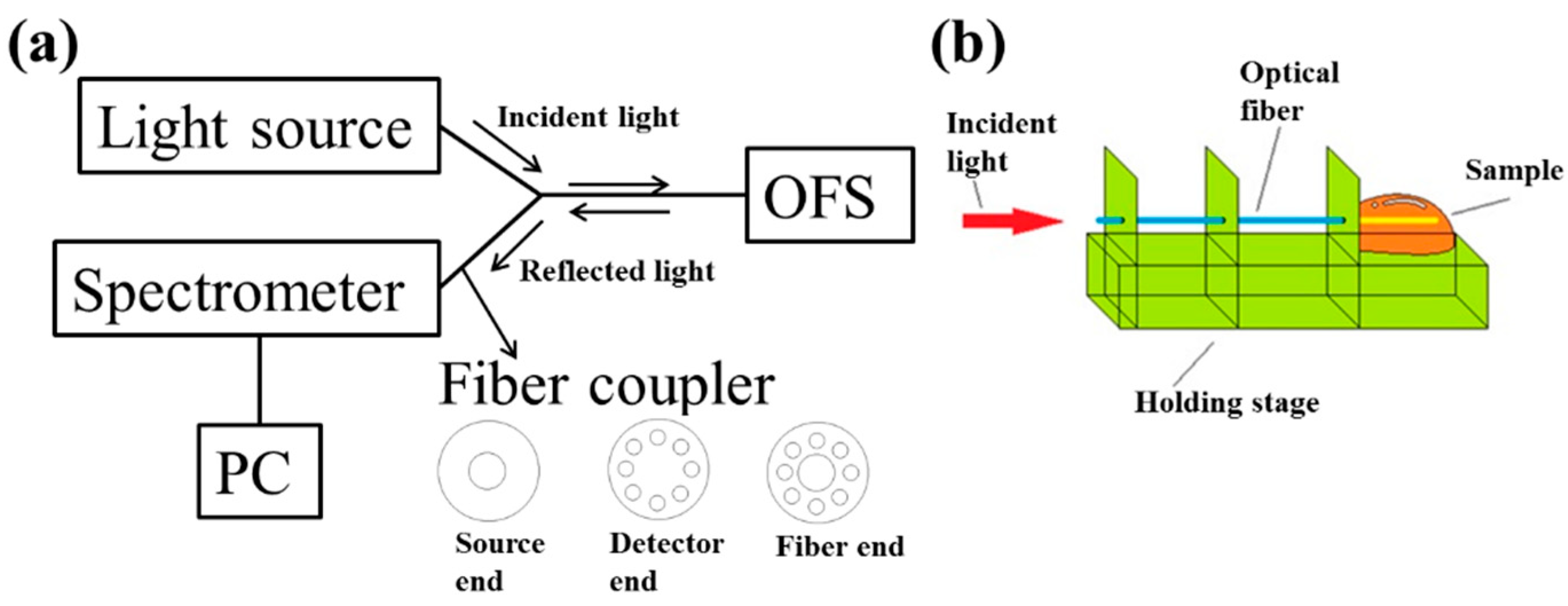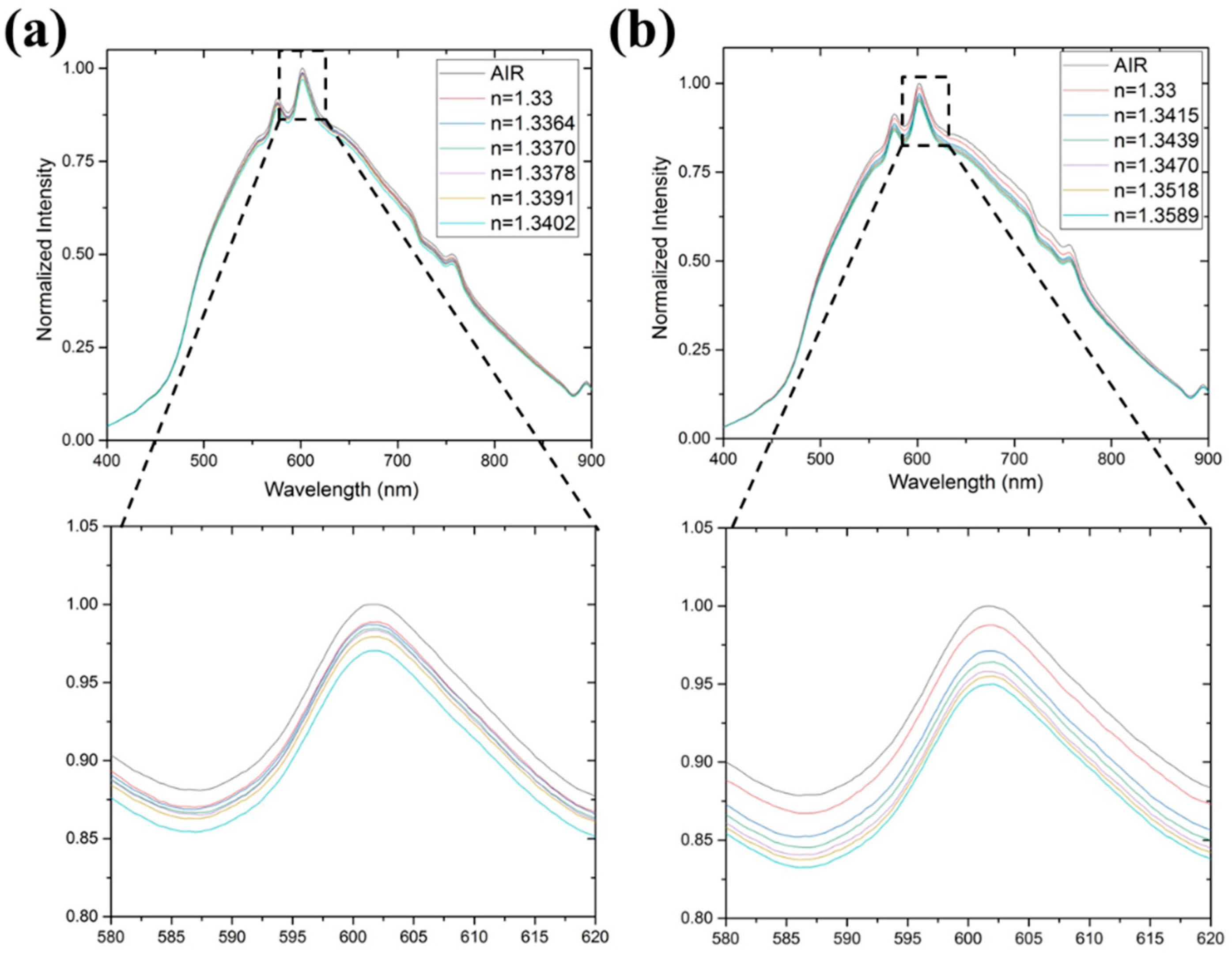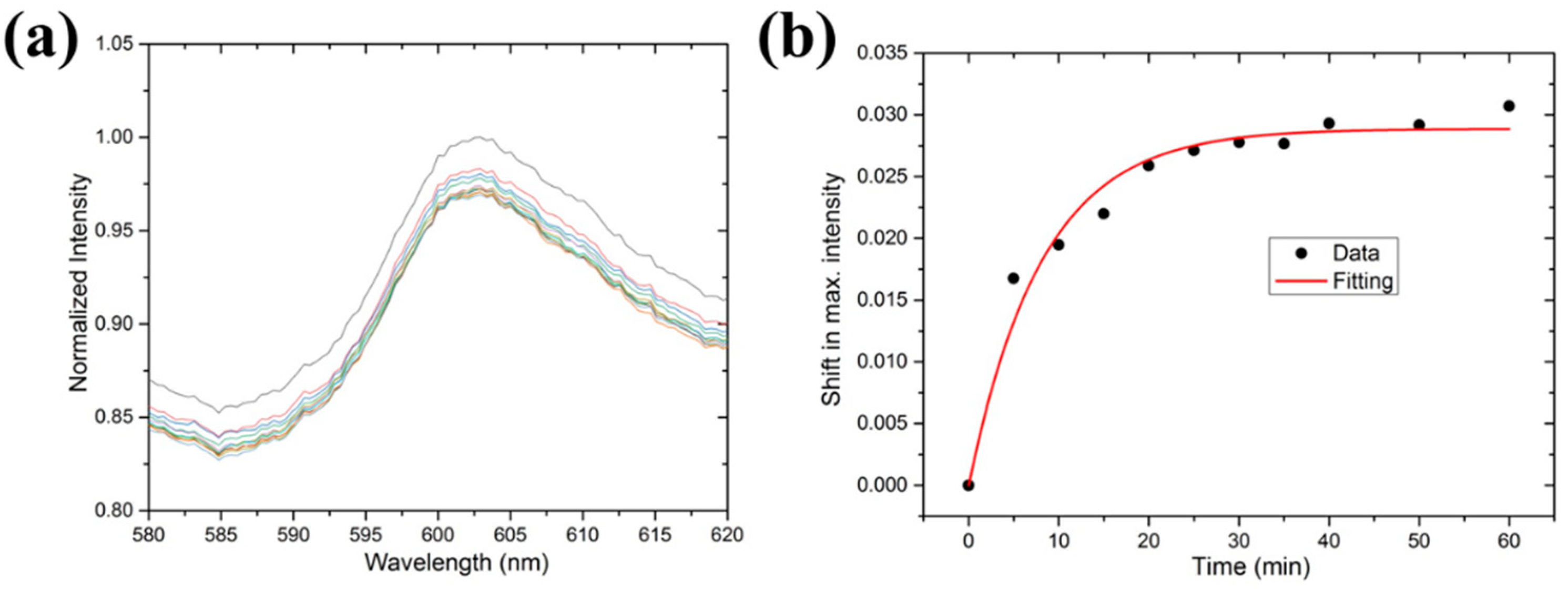Fabrication of a Bare Optical Fiber-Based Biosensor
Abstract
:1. Introduction
2. Materials and Methods
2.1. SPR Phenomenon
2.2. Fabrication of the OFS
2.3. Materials
2.4. Experimental Setup
3. Results and Discussion
3.1. Spectra
3.2. Sensitivity
3.3. BSA Binding
4. Conclusions
Author Contributions
Funding
Conflicts of Interest
References
- Sun, Y.S. Optical Biosensors for Label-Free Detection of Biomolecular Interactions. Instrum. Sci. Technol. 2014, 42, 109–127. [Google Scholar] [CrossRef]
- Sharma, A.K.; Jha, R.; Gupta, B.D. Fiber-optic sensors based on surface plasmon resonance: A comprehensive review. IEEE Sens. J. 2007, 7, 1118–1129. [Google Scholar] [CrossRef]
- Sun, Y.S.; Landry, J.P.; Fei, Y.Y.; Zhu, X.D.; Luo, J.T.; Wang, X.B.; Lam, K.S. Effect of fluorescently labeling protein probes on kinetics of protein-ligand reactions. Langmuir 2008, 24, 13399–13405. [Google Scholar] [CrossRef] [PubMed]
- Sun, X.L.; Shu, X.W.; Chen, C.H. Grating surface plasmon resonance sensor: angular sensitivity, metal oxidization effect of Al-based device in optimal structure. Appl. Optics 2015, 54, 1548–1554. [Google Scholar] [CrossRef] [PubMed]
- Sun, Y.S.; Li, C.J.; Hsu, J.C. Integration of Curved D-Type Optical Fiber Sensor with Microfluidic Chip. Sensors 2016, 17, 63. [Google Scholar] [CrossRef] [PubMed]
- Villuendas, F.; Pelayo, J. Optical fibre device for chemical seming based on surface plasmon excitridon. Sens. Actuat. A 1990, 23, 1142–1145. [Google Scholar] [CrossRef]
- Luan, N.; Wang, R.; Lv, W.; Yao, J. Surface plasmon resonance sensor based on D-shaped microstructured optical fiber with hollow core. Optics Express 2015, 23, 8576–8582. [Google Scholar] [CrossRef] [PubMed]
- Wang, S.F.; Chiu, M.H.; Chang, R.S. New idea for a D-type optical fiber sensor based on Kretschmann’s configuration. Optics Eng. 2005, 44, 030502. [Google Scholar]
- Wang, S.F.; Chiu, M.H.; Hsu, J.C.; Chang, R.S.; Wang, F.T. Theoretical analysis and experimental evaluation of D-type optical fiber sensor with a thin gold film. Optics Commun. 2005, 253, 283–289. [Google Scholar] [CrossRef]
- Roh, S.; Chung, T.; Lee, B. Overview of the characteristics of micro- and nano-structured surface plasmon resonance sensors. Sensors 2011, 11, 1565–1588. [Google Scholar] [CrossRef] [PubMed]
- Esteban, O.; Diaz-Herrera, N.; Navarrete, M.C.; Gonzalez-Cano, A. Surface plasmon resonance sensors based on uniform-waist tapered fibers in a reflective configuration. Appl. Optics 2006, 45, 7294–7298. [Google Scholar] [CrossRef] [PubMed]
- Bueno, F.J.; Esteban, O.; Diaz-Herrera, N.; Navarrete, M.C.; Gonzalez-Cano, A. Sensing properties of asymmetric double-layer-covered tapered fibers. Appl. Optics 2004, 43, 1615–1620. [Google Scholar] [CrossRef] [PubMed]
- Kawano, M.S.; Kamikawachi, R.C.; Fabris, J.L.; Müller, M. Fiber optic sensor for methanol quantification in biodiesel. In Proceedings of the 23rd International Conference on Optical Fibre Sensors, Santander, Spain, 2 June 2014. [Google Scholar]
- Morisawa, M.; Muto, S. Plastic Optical Fiber Sensing of Alcohol Concentration in Liquors. 2012. Available online: https://www.hindawi.com/journals/js/2012/709849/ (accessed on 6 August 2019).
- Tarca, R.C.; Caraban, A.M.; Bota, S.; Tarca, I.C.; Dergez, A.; Cozma, A.C. A New Optic Fiber Sensor for Measuring the Concentration of Ethanol in Wine. Rev. Chim-Bucharest. 2014, 65, 1238–1241. [Google Scholar]
- Sun, Y.S.; Landry, J.P.; Fei, Y.Y.; Zhu, X.D. An Oblique-Incidence Reflectivity Difference Study of the Dependence of Probe-Target Reaction Constants on Surface Target Density Using Streptavidin-Biotin Reactions as a Model. Instrum. Sci. Technol. 2013, 41, 535–544. [Google Scholar] [CrossRef]






© 2019 by the authors. Licensee MDPI, Basel, Switzerland. This article is an open access article distributed under the terms and conditions of the Creative Commons Attribution (CC BY) license (http://creativecommons.org/licenses/by/4.0/).
Share and Cite
Zhang, Y.-J.; Hsu, J.-C.; Tsao, J.-H.; Sun, Y.-S. Fabrication of a Bare Optical Fiber-Based Biosensor. Micromachines 2019, 10, 522. https://doi.org/10.3390/mi10080522
Zhang Y-J, Hsu J-C, Tsao J-H, Sun Y-S. Fabrication of a Bare Optical Fiber-Based Biosensor. Micromachines. 2019; 10(8):522. https://doi.org/10.3390/mi10080522
Chicago/Turabian StyleZhang, Yu-Jun, Jin-Cherng Hsu, Jia-Huey Tsao, and Yung-Shin Sun. 2019. "Fabrication of a Bare Optical Fiber-Based Biosensor" Micromachines 10, no. 8: 522. https://doi.org/10.3390/mi10080522




